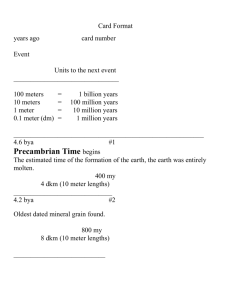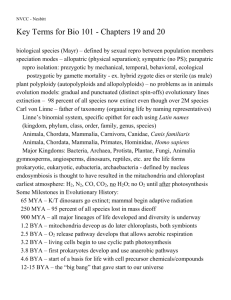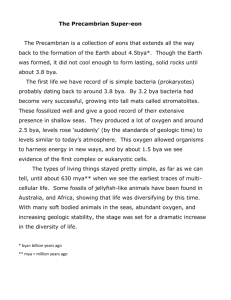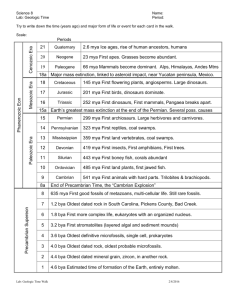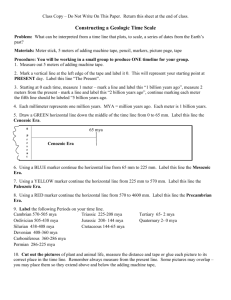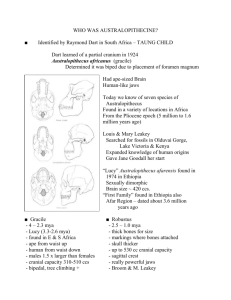Lab_Geologic_Time_cards_Teacher script
advertisement
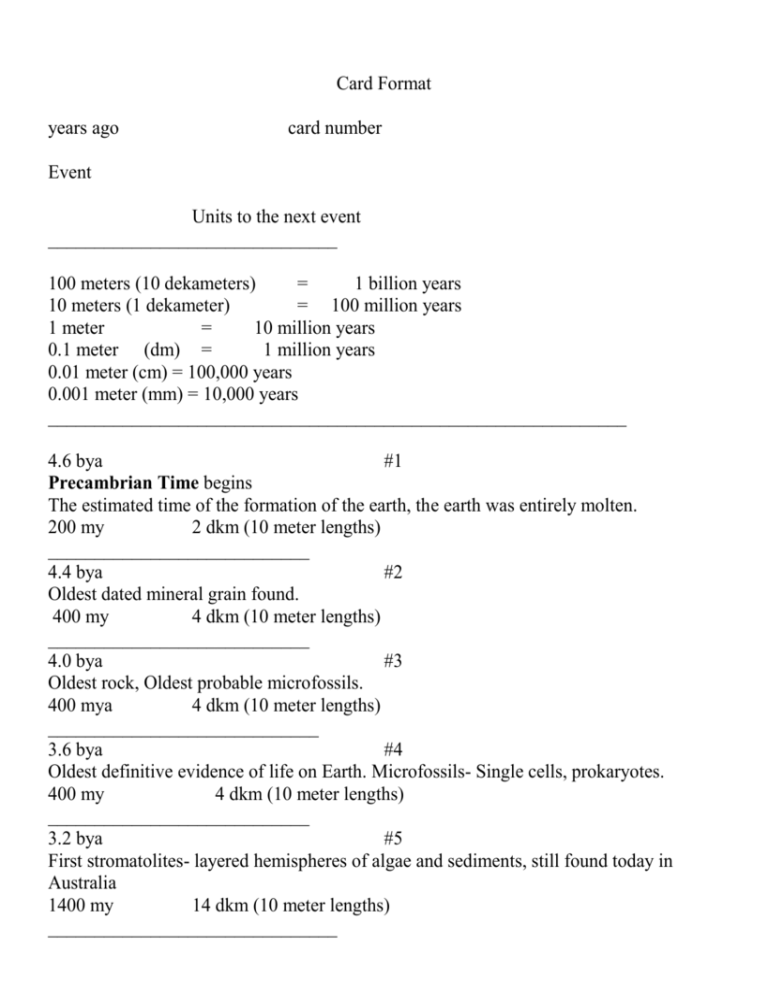
Card Format years ago card number Event Units to the next event _______________________________ 100 meters (10 dekameters) = 1 billion years 10 meters (1 dekameter) = 100 million years 1 meter = 10 million years 0.1 meter (dm) = 1 million years 0.01 meter (cm) = 100,000 years 0.001 meter (mm) = 10,000 years ______________________________________________________________ 4.6 bya #1 Precambrian Time begins The estimated time of the formation of the earth, the earth was entirely molten. 200 my 2 dkm (10 meter lengths) ____________________________ 4.4 bya #2 Oldest dated mineral grain found. 400 my 4 dkm (10 meter lengths) ____________________________ 4.0 bya #3 Oldest rock, Oldest probable microfossils. 400 mya 4 dkm (10 meter lengths) _____________________________ 3.6 bya #4 Oldest definitive evidence of life on Earth. Microfossils- Single cells, prokaryotes. 400 my 4 dkm (10 meter lengths) ____________________________ 3.2 bya #5 First stromatolites- layered hemispheres of algae and sediments, still found today in Australia 1400 my 14 dkm (10 meter lengths) _______________________________ 1.8 bya #6 First more complex forms of life, the eukaryotes. Organized nucleus. Still single cell though. 600 my 6 dkm (10 meter lengths) _______________________________ 1.2 bya #7 Oldest dated rock in South Carolina. It was found in Pickens County. 565 my 5.65 dkm (10 meter lengths) ______________________________ 635 mya #8 The first good fossils of metazoans- multi-cellular life evidence of jellyfish, soft corals, worms, arthropods. Found as fossils in Australia. Fossils are RARE. All soft-bodied. 94 my 9.4 meters 8a End of Precambrian Time, Cambrian Explosion ______________________________________________________________ 541 mya #9 Cambrian Period. Beginning of Paleozoic Era “Ancient Life”. All before was the PreCambrian (86% of all time). First hard parts, more abundant fossils. Trilobites and brachiopods. Evidence from stromatolites suggests 435 days/yr. 56 my 5.6 m ______________________________ 485 mya #10 Ordovician Period First land plants, First jawed fish. Appalachians begin to form. 42 my 4.2 m. ____________________________ 443 mya #11 Silurian Period Corals and other invertebrates are abundant. First boney fish. Piedmont collides with North America. 24 my 2.4 m _______________________________ 419 mya #12 Devonian Period Fish become abundant. First insects. First amphibians. First trees. 60 my 6m ____________________________ 359 mya #13 Mississippian Period large coal swamps, sharks, crinoids; First land vertebrates Glaciation in polar areas. 36 my 3.6 m. _______________________________ 323 mya #14 Pennsylvanian Period more coal, first reptiles 24 my 2.4 m. ____________________________ 299 mya #15 Permian Period First archeosaurs. Glaciation in the southern hemisphere. Conifers develop. Pangaea forms, Appalachian mountains form 41 my 4.1 m. 15a End of the Paleozoic Era Climate change and lowering of sea level causes a large mass extinction. Other possible causes were volcanic activity and meteor impact. _______________________________ 252 mya #16 Triassic Period. Mesozoic Era “Middle Life” begins. First dinosaurs, first mammals, North America and Africa begin rifting apart at the end of the period. 51 my 5.1 m. _____________________________ 201 mya #17 Jurassic Period Dinosaurs! and first birds. Mountain building in western North America. 56 my 5.6 m. _______________________________ 145 mya #18 Cretaceous Period Angiosperms (flowering plants) appear. Many large dinosaurs. 79 my 7.9 m. ________________________________________________________ 18a End of the Mesozoic Era Probable large asteroid or comet impact at the Yucatan in Mexico caused the mass extinction of the dinosaurs and many other forms of life. ______________________________________________________________ 66 mya #19 Cenozoic Era “Modern Life” begins. Paleogene Period. Mammals dominate. Mountain building- Alps in Europe, Himalaya- Asia, Andes- S. America 43 my 4.3 m. _______________________________ 23 mya #20 Neogene Period. Grasses are abundant, First apes. 20.4 my 2.04 m ___________________________________________________________ 2.6 mya #21 Quaternary Period Widespread glaciation. Advances and retreats of ice sheets up to about 15,000 years ago. We are still in the Quaternary Period. Rise of human ancestors, humans from 200,000 ya All of civilization has occurred in the last 6,000 years. Less than 1 mm on our scale of 1 meter for 10 million years. 0.26 meters to the present _______________________________ 100 meters = 1 billion years 10 meters = 100 million years 1 meter = 10 million years 0.1 meter (dm) = 1 million years 1 centimeter = 100 thousand years 1 millimeter = 10 thousand years 0.1 mm = 1 thousand years (put your thumb and index finger together, then move apart to just see light, thickness of a sheet of paper)
